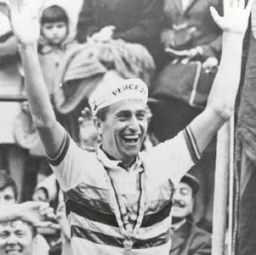Tom Simpson Biography
Tom Simpson – celebrating 1965 World Championship Title
An iconic cyclist of the 1960s, Tom Simpson had a unique drive and ability. He was the first British cyclist to become a major cycling star winning the World Championship in 1965. Tragically, Simpson died during the 1967 Tour de France whilst climbing Mont Ventoux. Even more shocking was the revelation that Simpson had packets of amphetamines in his back pocket, and the use of drugs had been a contributory factor to his untimely death.
Tom Simpson – Early Life
Tom Simpson was born in County Durham, the youngest child of a coal miner in 1937. The family later moved to Nottingham where Tom became interested in cycling. He competed in time trials, road races and on the track. It was on the track where he had his first taste of international success; he won a bronze medal in the 1956 Olympics as part of Great Britain’s team pursuit squad.
In April 1959, he felt he needed to travel abroad to try and win a place in a professional cycling team. (At the time the domestic British scene offered little for an aspiring professional cyclist. He left for Brittany, where he raced in amateur races and also met his future wife Helen Sherburn.
Life as a Pro Cyclist
After winning a couple of amateur races he was offered a contract with Rapha Geminiani Team, who also had British cyclist Brian Robinson on the squad.
By 1960 he completed his first Tour de France, finishing a very creditable 29th.
In 1962, he became the first British cyclist to wear the maillot jaune of the Tour, eventually finishing 6th overall.
By 1963, he was riding for a new team Peugeot BP (with distinctive black and white jerseys). He won the Milan San Remo classic in 1964.
1965 was probably his most successful year as he was crowned World Road Race champion in San Sebastian, Spain and also won the autumn classic Giro Di Lombardia. For his exploits, he became the first cyclist to win the BBC sports personality of the year.
1966 was a disappointing year, due to a skiing injury. However, in 1967, he proved to be in excellent form, winning the early season Paris Nice race and two stages in the Vuelta a Espagne. Going into the 1967 Tour de France, Simpson felt he had a realistic chance of being on the podium
Death of Tom Simpson on Mont Ventoux
On Thursday, 13th July, the 13th Stage of the Tour the weather was very hot. In those days, riders were actually limited to 4 bidons a day (the effects of dehydaration were clearly misunderstood). At the foot of Mont Ventoux, Simpson attacked hoping to move up the general classification. Later he was overtaken by Jan Jensen (the eventual stage winner) and 4 others. Near the summit, Simpson started to zig zag across the road, looking very pale and exhausted and he eventually fell off. His team manager tried to stop Simpson (he was actually worried Simpson might fall off on the descent) However, Simpson got back on his bike and cycled another 500 metres before falling into the hands of his helpers (with his hands still on his handlebars). This time Simpson was unconscious. The race Doctor tried to give Simpson mouth to mouth resuscitation to no avial; he was airlifted to hospital. But, Simpson was declared dead on arrival.
“Put Me back on My Bike”
This famous phrase was attributed to Simpson by Sid Saltmarsh, who was a journalist for Cycling and The Sun. Sid was not actually at the race and Simpson never said these words. According to his team manager, his last words were ‘Go on, Go on’. However, although Simpson didn’t say these words they epitomised his attitude of being willing to ride himself into the ground. It appears that one effect of the drugs he took was that it was harder to be aware of his own limits.
The cause of death was given as heart attack brought on by heat, dehydration and exacerbated by alcohol and use of amphetamines.
Aftermath
The cycling community was shocked by his death. The next stage of the Tour was a procession, with the British riders allowed to cross the finishing line first (Barry Hoban happened to be first)
At first the link between his death and drugs was not widely publicised. It took time for revelations about amphetamines and other drugs to be released. A search of Simpson’s apartment the next day found more drugs – Stenamina and Tonedrin.
Tom Simpson’s death did mark a turning point in the use of drugs in professional cycling. After his tragedy, the UCI did start to implement more drug testing, although its efficacy was open to question. Many riders such as Jacques Anquetil retained a resistance to dope testing. Even now, the culture of doping in the professional cycling scene still perists.
Reputation Tom Simpson
Tom Simpson’s memory evokes a mixture of responses. In many ways he was Britain’s most successful and prominent rider. He rode at a time when dope taking was rife and drug tests sparodic to say the least. Tom Simpson embodied tremendous determination and drive to win. He showed the way to a generation of British riders. But, his career has always been overshadowed by the knowledge of his extensive doping and his willingness to push himself so far, he ended up paying the ultimate price. Yet, despite his tragic death, he is held in high regard by the Cycling fraternity. A monument was erected to Tom Simpson near to where he collapsed on Mont Ventoux; it receives thousands of visitors every year.
Related
In 2001, Cycling Weekly voted Tom Simpson as the second greatest British cyclist of the twentieth Century. Admitting that his drug use cost him first place (given instead to Chris Boardman)


